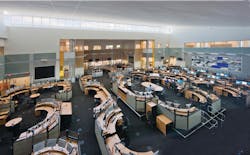Emergency Communications: Designing & Operating Your Dispatch Center
Just as fire stations have evolved from simple sheds into the multi-bay structures of today, the new generation of emergency communications centers has little likeness to those past. Underground bunkers that were products of the Cold War era have given way to energy-efficient facilities that make abundant use of natural light while still providing high levels of security.
There have been significant changes in technology as well, to the point that nothing even remotely resembling a telephone can be found. Dispatch has definitely gone digital, from the replacement of analog switches by virtual buttons on a computer screen to the change from reel-to-reel recording tape to disc-drive storage of audio. This article highlights the features and functions of the communications center of the 21st century.
Fewer PSAPs
One of the biggest differences in modern Public Safety Answering Points (PSAPS) is that there will likely be fewer of them. Fiscal realities along with state and local action are bringing pressure to merge to bear. For example, the entire state of Maine has only 26 PSAPs, Indiana allows no more than two per county, Ohio and Massachusetts are vigorously pursuing consolidation and Washington State – according to documents published on an official website – is “proactively addressing regionalization.”
Nor has the federal government been silent on this topic. In a Feb. 22, 2013,”Report to Congress and Recommendations on Legal and Regulatory Framework for Next Generation 9-1-1 Services,” the Federal Communications Commission (FCC) advised that “Congress should encourage the development of consolidated regional Next Generation 9-1-1 (NG 9-1-1) call centers where possible, for example, by offering preference for grant eligibility to states and regions that make progress toward this goal.”
Still, not every agency is supportive of consolidation. As of this writing, the cities of Coral Springs and Plantation have opted not to participate in a proposed project in Broward County, FL, aimed at reducing both the number of 9-1-1 centers and the number of calls transferred between PSAPs.
Regardless of the number of dispatch facilities in a community, the concept that an emergency communications center must have four brick-and-mortar walls will also be challenged as technology moves forward. NG 9-1-1 will be comprised of several components. Location information, for example, will no longer be stored in tabular files, but rather attached to the request for assistance through geographic coordinates. This will change the way that dispatch does business, as well as the equipment required – both inside and outside the PSAP – to make this possible.
Up in the “cloud”
The use of the so-called “cloud” will also increasingly become a part of the fire service communications vocabulary. Data will be stored remotely – some shared and some not, because security remains a critical issue. Terms like “distributed processing” will also take on a new meaning. When currently used, it typically refers to computer systems that rely on the horsepower of desktops in addition to the centralized server. Taking this forward, these activities will be taken offsite. Even now, some communications PSAPs have opted to have their 9-1-1 calls received at remote data centers, then relayed back for call takers to answer and process.
Another exciting related prospect is the possibility of off-duty personnel using their home computers to manage 9-1-1 calls. During major emergencies, call center staffing could be immediately increased by mobilizing dispatchers from their kitchens and dens. Saving significant time over physical call-backs, especially during inclement weather, such procedures would provide a new and immediate way of ramping up resources when they are needed the most.
Another part of the transformation of PSAPs from the 20th century to the 21st is the focus on LEED (Leadership in Environmental Energy and Design) standards. In this case, moving from the “dark ages” is certainly a true statement, with the use of outside light and the provision of views being two of many categories in which certification points can be earned. Focus is also placed on livable, energy-efficient buildings. Concern for interior air quality, the use of renewable or recycled goods during construction and the overall reduction in the use of utilities are among the many variables rated.
Building design takes into account not only the function of the structure, but the comfort of the occupants as well. Large kitchens and break areas that take into account the 24-hour nature of the operation and need to support protracted operations are becoming common. Some newer additions include “quiet rooms” where dispatchers can read or relax during breaks. For the more active, exercise rooms are also a welcome addition, where stress and calories can both be burned off after a hectic shift.
There are also a number of pleasing interior finishes that may be used to further increase worker satisfaction. Far from the institutional mint-and-bottle-green walls of many an older public building, renewable and recycled surfaces in many colors and finishes now appear. Acoustic wall panels and flooring that looks like wood, LED lighting and high ceilings provide a functional, yet appealing design. Alternative energy systems such as geo-thermal and solar have also found a niche, as have low- and no-flow plumbing fixtures.
Security concerns
But the main purpose of the PSAP is far from being forgotten. According to National Fire Protection Association (NFPA) 1221, Standard for the Installation, Maintenance and Use of Emergency Services Communications Systems, 2013 edition, “The communications center and other buildings that house essential operating equipment shall be protected against damage from vandalism, terrorism and civil disturbances.”
Whereas security used to be provided by digging deep into the ground, it is now a product of the engineered use of construction materials, bullet-resistant glazing, offset distances from potential hazards and electronic monitoring and control systems. Even facilities in areas prone to severe weather such as hurricanes and tornadoes are now routinely built above ground. This also applies to emergency operations centers (EOCs) that are often part of the package, as are traffic management centers (TMCs).
According to Kevin Ratigan, senior vice president of Architects Design Group in Winter Park, FL, “We have worked on several facilities located in large, urban metro areas. Traffic management centers are a national trend in these areas. The TMC shares a similar infrastructure backbone of fiber optic connectivity and visual display technology as the communications center. Although the TMC is not located in the same floor area as communications owing to law enforcement accreditation and often state statute for privacy of information, the visual displays will be integrated as a ‘backup’ to the TMC for monitoring by the communications center personnel. Often, the TMC will be located next to the communications center to cost effectively share the technology backbone.”
One of the challenges of modern-day security is to provide the maximum protection with the minimum visibility. Building exteriors no longer look like fortresses, but most often resemble ordinary offices or light industrial concerns. Perimeter control is achieved by a variety of measures, including landscaping, bollards (thick posts that prevent vehicles from entering an area) and the creative use of steps, planters and benches. Once inside, visitors are greeted with warm and open, yet isolated spaces that route pedestrian traffic away from critical areas. Keypads, badge readers, and biometric sensors provide an additional level of safety. Glazing and walls, where required, are bullet resistant.
Another sign of the times is protection against chemical, biological, radiation, and nuclear (CBRN) hazards. This in part encompasses the location of fresh-air intakes, the ability to quickly cut off the fresh air supply, HEPA and charcoal filtration, positive pressurization and air quality monitoring. While many find the total range of these measures cost-prohibitive, NFPA 1221 considers the first two as basic requirements.
This same NFPA standard also speaks to a variety of other issues, calling for among other things, “at least two independent and reliable power sources” and a “means for connecting a portable or vehicle-mounted generator.” Also specified is the use of Uninterruptible Power Supplies (UPS) to augment the motor-driven generators. These devices provide a margin of safety should the generators fail, but just as important they filter electricity during periods of normal operation, protecting critical equipment from fluctuations in voltage and spikes.
Battery backups
With the proliferation of sensitive electronics within the dispatch center, UPS protection is a must – and so is having room for current and future operational systems. One of the recurring themes uncovered during discussions with agencies having recently built dispatch facilities was concern over having enough space, cooling and power to supply future growth. Included here is sufficient square footage to allow for the installation of new equipment and replacement of old systems. Since communications systems must always remain live, providing a buffer makes forward migration a much easier task.
Perhaps the most complex discussion arises over how much space is too much – and how much space is not enough. While the virtualization of servers (the running of multiple applications on one device) can help to reduce demand, the growing popularity of “blade servers” which move equipment from the dispatch center floor to the computer room may actually up the requirements. During the projected life-spans of these projects it is almost impossible to guess how many new applications will be placed into everyday use by the fire service or by other services within multi-jurisdictional facilities. (How ubiquitous is this spread of technology? In 2000, for example, the dispatch center I manage had two server based computer applications. Today, we have almost 80. Tomorrow – who knows?) But modern dispatch center design must pay increasing heed to the space needed for technology.
Space too is a requirement, when it comes to storage. Because it is not an operational component, it is often overlooked in the planning stages, with painful results once the building is occupied. Take a look around your dispatch center. How many items do you need to keep it running? Obviously, there are spare parts for radios, computers and mechanical equipment. But don’t forget devices such as headsets and spare uniforms, as well as space for extra chairs. Staff will need a place to store their coats and personal items. General office and janitorial supplies are also on the list, as are public education and training materials. It doesn’t take long before all of this adds up.
New Technology
Both intelligent highways and crash-notification systems will likely both report directly to the PSAP, providing additional information to process and store. All of these will be displayed on LED monitors, which have helped to reduce the profile of modern adjustable dispatch consoles. Radio transmissions themselves will be controlled by devices that use Internet Protocol (IP) networks. While these will not use the World Wide Web, they will use the same technology, but on a closed and secured system.
The consoles on which this technology rides will carry forward much of today’s best features such as cable management, personal comfort heat and air units, and adjustments to allow the telecommunicator to work in a sitting or standing position. Additionally, swivel and extension arms, similar to those used on home TVs, will allow the monitors to be adjusted, as well. Ease of maintenance also increasingly calls for components to be located above the raised floor. While wiring will continue to run beneath, may agencies are locating routers and other devices in enclosures that complement the dispatch decor.
Call-handling procedures will also continue to evolve. Emergency medical dispatch (EMD) and emergency fire dispatch (EFD) will continue to change in order to address these new challenges. CAD systems that allow users to generate their own call-handling decision trees are also gaining in popularity, and the increased use of mapping will continue. Logging recorders and Records Management Systems (RMS) will also evolve as a result of NG 9-1-1 and FirstNet, and an increasingly open architecture will allow for barrier free transfer of data between applications; something that does not routinely happen today. An increasing number of radio systems that meet the Association of Public-safety Communications Officials (APCO) Project 25 Standard will also be brought live, which will further increase interoperability and also place demands on logging.
Decades of change
During the past 40 years, perhaps no other area of the fire-rescue service has seen such radical change as emergency communications, and nowhere can these changes can be more easily seen than in the dispatch center.
Just as the contents of apparatus bays have progressed from horses to steam and then to diesel, so too have the contents of the dispatch center. Massive telephones with rows of buttons have given way to electronic images on a computer monitor. The punch cards that replaced the pen and paper have now themselves been replaced by CAD. And the ritual of changing the recorder tape at midnight has now passed into memory. Accordingly, the facilities themselves have also changed. What is seen today is a brand-new century in dispatch design and operation. Many external connections can be expected to involve Personal Digital Assistants (PDAs) netbooks and eventually devices that have not yet been invented.
BARRY FUREY, a Firehouse® contributing editor, is director of the Raleigh-Wake Emergency Communications Center in North Carolina. During his 35-year public safety career, he has managed 911 centers and served as a volunteer fire officer in three other states. In 2005, Furey received a life membership in the Association of Public-safety Communications Officials (APCO) International for his continued work in emergency communications.
HELPFUL LINKS FOR FIRE DEPARTMENTS
ASSOCIATION OF PUBLIC-SAFETY COMMUNICATIONS OFFICIALS, INTERNATIONAL (APCO)
http://www.apco911.org/standards/apco-standards-for-download.html
NATIONAL FIRE PROTECTION ASSOCIATION (NFPA) STANDARD 1221
http://www.nfpa.org/aboutthecodes/aboutthecodes.asp?docnum=1221
NATIONAL EMERGENCY NUMBER ASSOCIATION (NENA) STANDARDS
http://www.nena.org/?page=Standards
ASTM STANDARD GUIDE FOR EMERGENCY OPERATIONS CENTER (EOC) DEVELOPMENT
http://www.astm.org/DHS/E2668.pdf
U.S. DEPARTMENT OF TRANSPORTATION NEXT GENERATION 9-1-1 INITIATIVE

Barry Furey
BARRY FUREY, who is a Firehouse Contributing Editor, provides consulting and training services in emergency communications. He is the former director of the Raleigh-Wake Emergency Communications Center in North Carolina. During his 50-year public safety career, he has managed 9-1-1 centers and served as a volunteer fire officer in three other states. In 2005, Furey received a life membership in the Association of Public-Safety Communications Officials (APCO) International for his continued work in emergency communications. Furey was inducted into the Firehouse Hall of Fame in 2017.






